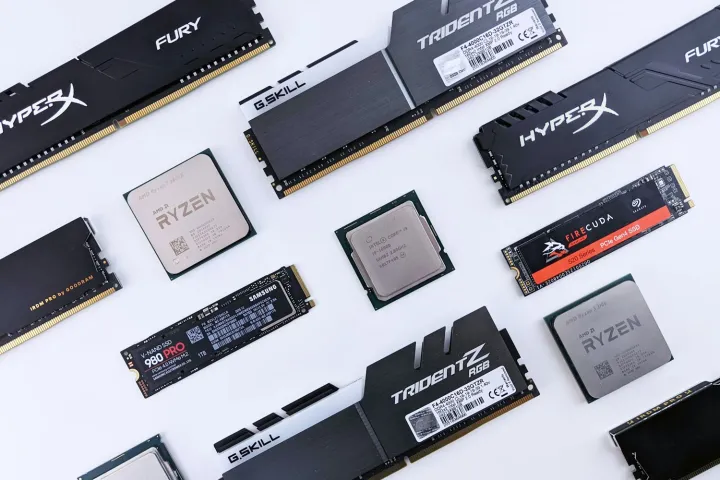In today’s fast-paced digital age, a slow computer can be incredibly frustrating—especially when you’re trying to game, stream, or even just browse the web. Whether you’re building a new PC or looking to upgrade your existing setup, two key components can drastically enhance your computer’s speed and responsiveness: SSD and DDR5 RAM.
But what makes SSDs and DDR5 RAM so powerful? Why are they considered game-changers in the world of computing? And how can you ensure you’re choosing the right ones for your system?
In this comprehensive guide, we’ll explore the incredible impact of SSD and DDR5 RAM on computer performance, how they work together, and what to consider before investing in these technologies. Let’s dive in.
What Are SSD and DDR5 RAM?
Before we get into the technical nitty-gritty, let’s break down these two crucial components.
What is an SSD?
SSD stands for Solid State Drive. Unlike traditional hard disk drives (HDDs), which use spinning disks and moving parts, SSDs use flash memory to store data. This results in:
- Much faster data access
- Lower power consumption
- Greater durability (no moving parts to wear out)
SSDs come in different formats—SATA, M.2, and NVMe. NVMe SSDs are currently the fastest, often delivering read/write speeds over 3,000 MB/s, compared to the 100–150 MB/s speeds of an average HDD.
What is DDR5 RAM?
RAM (Random Access Memory) is your computer’s short-term memory. DDR5 is the fifth generation of Double Data Rate Synchronous Dynamic RAM, succeeding DDR4. Key features of DDR5 RAM include:
- Higher bandwidth and faster data rates
- Lower power consumption
- Improved efficiency for multitasking and intensive applications
While DDR4 maxes out around 3200 MHz, DDR5 modules often start at 4800 MHz and can exceed 7000 MHz in high-end setups.
How SSD and DDR5 RAM Work Together
You might be wondering: how do these two components—storage and memory—work together?
While they serve different functions, they complement each other beautifully:
- SSD improves load times—booting up Windows, launching programs, loading games or files.
- DDR5 RAM helps with multitasking and real-time performance—keeping multiple browser tabs open, editing videos, running virtual machines, etc.
Together, SSD and DDR5 RAM can give your PC a turbo boost, cutting down on lags and improving responsiveness across the board.
The Evolution of Storage: From HDD to SSD
Let’s rewind a bit to understand why SSDs are such a massive leap forward.
HDDs: The Old Standard
Hard Disk Drives have been around for decades. They’re cheaper and offer more storage per dollar, but they’re also:
- Slower due to mechanical parts
- More prone to physical damage
- Heavier and noisier
SSDs: The New King
SSDs are now widely preferred for operating systems, games, and applications. Here’s why:
| Feature | HDD | SSD |
|---|---|---|
| Speed | 100-150 MB/s | 500 MB/s – 7000 MB/s |
| Noise | Audible spinning | Silent |
| Durability | Prone to damage | Shock-resistant |
| Boot Time | 30-60 seconds | 5-10 seconds |
In short, upgrading to an SSD is like going from a bicycle to a Ferrari.
The Leap from DDR4 to DDR5 RAM
DDR4 has been the go-to memory standard for years, but DDR5 is here to stay—and it’s redefining performance.
Key Differences Between DDR4 and DDR5
| Feature | DDR4 | DDR5 |
|---|---|---|
| Base Frequency | 2133 – 3200 MHz | 4800 – 8400+ MHz |
| Maximum Module Size | 32 GB | 128 GB+ |
| Power Efficiency | Standard | ~20% more efficient |
| Burst Length | 8 | 16 |
With DDR5 RAM, your system gets more bandwidth, better multitasking, and future-ready performance for heavy-duty workloads.
Who Needs SSD and DDR5 RAM?
While anyone can benefit from faster performance, here are some use cases where these upgrades make a huge difference.
1. Gamers
Modern games demand faster storage and memory. SSDs reduce game loading times dramatically, while DDR5 RAM enhances frame rates and stability, especially in AAA titles.
2. Content Creators
If you edit 4K videos, use Photoshop, or create 3D models, you’ll love the performance boost from DDR5 RAM’s increased bandwidth. SSDs also help in handling massive project files efficiently.
3. Professionals
Software developers, architects, data analysts, and engineers who use memory-intensive software (e.g., AutoCAD, MATLAB, Visual Studio) will experience smoother multitasking and compile times.
4. Streamers and Multitaskers
Running OBS, Discord, browser tabs, and your game simultaneously? DDR5 RAM ensures smooth performance across all tasks, and SSDs make loading assets seamless.
How to Choose the Right SSD
When selecting an SSD, there are a few critical aspects to consider:
a) Type
- SATA SSD: Cheaper, slower (up to 550 MB/s)
- NVMe SSD (PCIe Gen 3/4/5): Expensive, but insanely fast (up to 14,000 MB/s in Gen 5)
b) Capacity
- 256GB–512GB: Good for basic needs
- 1TB–2TB: Ideal for gamers, creators, and multitaskers
- 4TB+: Best for professional use or large media libraries
c) Brand Reliability
Stick with reputed brands like Samsung, Crucial, WD, Kingston, or Sabrent.
How to Choose the Right DDR5 RAM
Here’s what to look for when buying DDR5 memory:
a) Speed (MHz)
Higher MHz = faster data transfer. 5600 MHz is great for most users, while overclockers may prefer 6400+ MHz.
b) Capacity
- 8GB–16GB: Basic tasks and light gaming
- 32GB–64GB: High-end gaming and content creation
- 128GB+: Workstations, servers, and heavy-duty use
c) Compatibility
Make sure your motherboard supports DDR5 RAM. Intel’s 12th Gen+ and AMD’s Ryzen 7000+ CPUs offer DDR5 compatibility.
How to Install SSD and DDR5 RAM
Installing SSD
- Power off your PC and unplug it.
- Mount the SSD (SATA or M.2 slot on your motherboard).
- Connect SATA/power cables (for SATA SSDs).
- Reboot and initialize the drive in Disk Management.
Installing DDR5 RAM
- Locate the RAM slots on your motherboard.
- Press the RAM into place until it clicks.
- Boot your system and check in BIOS or Task Manager that the RAM is detected.
Tips for Optimizing SSD and DDR5 RAM Performance
- Enable XMP (Extreme Memory Profile) in BIOS to maximize DDR5 speed.
- Keep at least 10–20% of your SSD free for best performance.
- Disable unnecessary startup apps to make use of fast RAM and SSD boot times.
- Regularly update firmware and drivers for SSDs.
Real-World Benchmarks: The Difference Is Clear
Here’s a simple benchmark comparison:
| Task | HDD + DDR4 | SSD + DDR5 |
|---|---|---|
| Boot Windows | 45 seconds | 8 seconds |
| Launch Photoshop | 22 seconds | 5 seconds |
| Game Loading (Cyberpunk) | 80 seconds | 12 seconds |
| Export 4K Video | 10 mins | 4 mins |
Is It Worth Upgrading to SSD and DDR5 RAM?
Absolutely. While upgrading your CPU or GPU can cost hundreds more, an SSD and DDR5 RAM upgrade gives you noticeable speed gains at a relatively lower cost. For most users, it’s one of the best bangs for your buck when optimizing PC performance.
Future-Proofing with SSD and DDR5 RAM
Technology moves fast. Investing in SSD and DDR5 RAM today doesn’t just benefit you now—it prepares your system for the next generation of apps, games, and operating systems. With AI, high-res gaming, and cloud-based tools on the rise, you’ll want all the speed you can get.
Final Thoughts
If your computer feels sluggish or unresponsive, the problem might not be your processor—it might be your storage and memory. Upgrading to SSD and DDR5 RAM is like giving your machine a brand-new life. From quicker startups to smoother multitasking and faster gaming, the benefits are immediate and impactful.
So if you’re ready to supercharge your PC, start with these two components. Whether you’re building a rig from scratch or upgrading an older system, SSD and DDR5 RAM are the keys to a fast, reliable, and future-proof computer.

